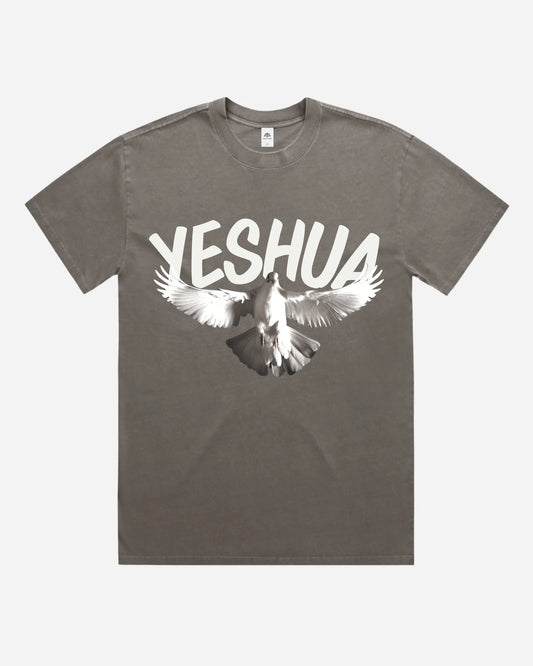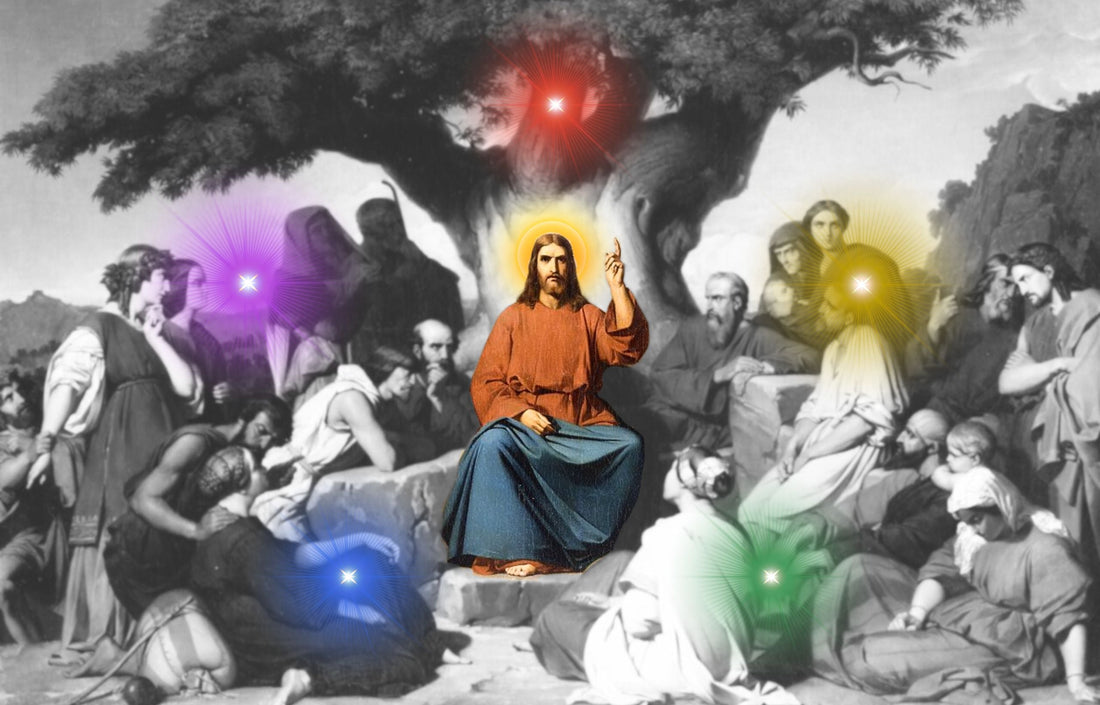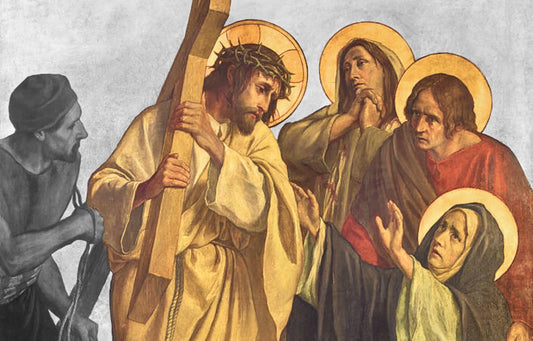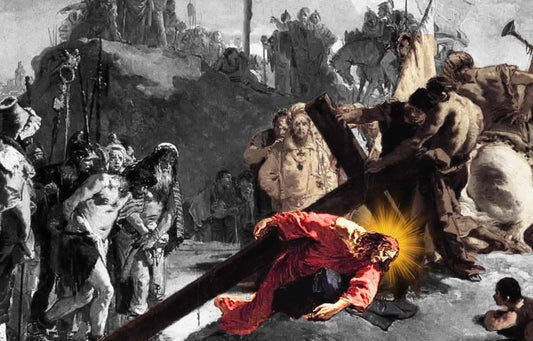Colors in Scripture are rich with symbolic meaning, that communicate spiritual truths. For example Red represents blood, and sin (Isaiah 1:18) and sacrifice’s power, while blue whispers of heaven’s nearness (Exodus 24:10) and God’s call to live differently. Understanding their symbolism unlocks deeper layers of meaning in God’s Word.
Biblical Colours and Their Meanings Overview
(Click on any color below to explore its symbolism in more detail.)
- Red – Stands for the atoning blood of Jesus, divine love, & the ultimate sacrifice that brings salvation & forgiveness.
- Blue – Points to heaven, divine revelation, spiritual authority, & the presence of the Holy Spirit descending like the sky.
- Purple – A sign of priestly calling, divine kingship, & royal identity, representing Christ as Mediator & King.
- Green – Symbolizes life, spiritual growth, prosperity, fresh beginnings, & flourishing in God’s grace.
- Gold – Symbolizes eternal divinity, divine nature, unchanging glory, heavenly wealth, & the majesty of God's throne & temple.
- Silver – Represents the Word of God, purity refined through fire, redemption, & the price paid for our salvation.
- Black – Represents sin, death, affliction, & mourning—but also the fertile soil where resurrection begins.
- White – Stands for righteousness, victory, joy, and the radiance of saints and angels in the presence of God.
- Yellow – Symbolizes faith tried by fire, divine joy, glory, & the anointing light of God’s presence.
- Amber – Represents God's glory revealed in judgment, His enduring presence, & the consuming fire of divine holiness.
- Orange – Symbolizes the fire of God's Spirit, bold deliverance, & vibrant praise born from a heart set free.
- Pink/Fuchsia – Reflects covenant love & restored relationship with God, rooted in joy, tenderness, & spiritual devotion.
- Scarlet – Associated with wealth, status, & sacred tabernacle linens—often pointing to royal dignity & sacrificial covering.
- Wine – Speaks of new birth, covenant renewal, spiritual multiplication, & the overflowing joy of God’s kingdom.
- Sapphire – Represents God’s commandments, heavenly clarity, and divine revelation through the Spirit and written Word.
- Turquoise – Reflects spiritual cleansing, healing streams, sanctification, and the refreshing hope of New Jerusalem.
- Brown – Reflects humility, human frailty, wilderness testing, and seasons of weariness that prepare for renewal.
- Emerald – Symbolizes renewal, prosperity, divine blessing, and the radiant beauty of God’s presence.
- Bronze – Represents strength, judgment, durability, and God’s righteous protection.
Red 🔴 – Blood, Sacrifice, and Sin
Red in the Bible is a symbol of both judgment and redemption—representing sin’s stain and the cleansing power of sacrificial blood.

Red as a Sign of Protection and Atonement
In Exodus 12:13, the Israelites marked their doorposts with lamb’s blood during Passover. This red sign shielded them from judgment and pointed forward to Christ, the true Passover Lamb. As Hebrews 9:22 affirms: “Without the shedding of blood, there is no forgiveness.”
Red as a Symbol of Sin
Red also reflects the depth of human guilt. In Isaiah 1:18, God says: “Though your sins are like scarlet, they shall be white as snow.”
The word scarlet (Hebrew: shani) describes a deep, ingrained stain—an image of sin that only divine mercy can cleanse.
Esau, Edom, and the Color of Regret
In Genesis 25:30, Esau trades his birthright for "red stew." His impulsive hunger ties him to the color red—his name becomes Edom, meaning "red." Later, the Edomites oppose Israel, turning red into a symbol of spiritual compromise and lost inheritance.
Christ’s Scarlet Robe: Mockery Turned Majesty
In Matthew 27:28, Roman soldiers drape Jesus in a scarlet robe to ridicule Him. Yet in doing so, they unknowingly affirm His kingship. The red robe becomes a symbol of divine royalty achieved through suffering.
Blue 🔵 – Divinity, Law, and the Heavens

Blue in Scripture represents the divine, the heavenly, and God’s unchanging covenant. Unlike red (blood and sin), blue points upward—to God’s holiness, His commands, and His promise to dwell among His people.
Blue as a Reminder of Heaven
In Exodus 24:10, Moses and the elders saw God standing on a pavement of "sapphire stone, as clear as the sky." This blue expanse mirrored the throne visions of Ezekiel (Ezekiel 1:26) and later John in Revelation (Revelation 4:6), where God’s presence is framed by the brilliance of lapis lazuli.
Blue as a Call to Obedience
God commanded Israel to attach blue threads to the tassels (tzitzit) of their garments (Numbers 15:38-39): "You will have these tassels to look at and so remember all the Lord’s commands." Unlike scarlet (worldly power) or crimson (sin), blue served as a constant prompt: Live differently. You are called higher.
The Priesthood and the Veil of Blue
The Tabernacle’s curtains (Exodus 26:1) and the high priest’s robe (Exodus 28:31) were woven with blue, symbolizing mediation between God and man. Even in exile, Esther’s royal robes (Esther 8:15) mirrored this color—unknowingly reflecting the divine authority Israel’s priesthood was meant to embody.
Purple 🟣 – Royalty, Priesthood, and Divine Authority
Purple in Scripture is the color of kings, priests, and divine sovereignty—a rare and costly dye that signified power, wealth, and sacred purpose.

Purple as a Mark of Royalty
In the ancient world, purple dye was extracted from rare sea snails, making it a luxury reserved for rulers. Esther 8:15 describes Mordecai clothed in royal purple after God’s deliverance, and Judges 8:26 mentions purple robes as spoils of kings. Even pagan rulers like the Babylonian and Persian monarchs (Daniel 5:7, Esther 1:6) used purple to display their authority—unknowingly mirroring the true King’s majesty.
Purple in the Tabernacle and Priesthood
God wove purple into the Tabernacle's fabric (Exodus 26:1) and the high priest's robes (Exodus 28:5) with purpose—this was the most expensive dye of antiquity, reserved for rulers and sacred duty.
More than just regal, purple marked the sacred intersection where kingship met priesthood, a living prophecy of Christ who would fulfill both roles perfectly (Hebrews 7:1-3). Purple declared God's ultimate plan: a Sovereign who would bridge the throne and the altar.
The Mockery and Majesty of Christ’s Purple Robe
In Mark 15:17-20, Roman soldiers dressed Jesus in purple to mock His claim as "King of the Jews." Yet their cruelty became divine irony: the fake robe proclaimed the truth. Christ’s kingship was not of this world (John 18:36), and His priesthood was perfected through suffering (Hebrews 2:10).
Green 🟢 – Life, Growth, and Restoration
Green in the Bible symbolizes life, fertility, and spiritual renewal. It’s the color of creation in motion—faith that’s alive and growing.

The Color of Living Things
Green is often used to describe vegetation and vitality. Psalm 23:2 says: “He makes me lie down in green pastures.” Here, green evokes peace and provision—God’s care that nourishes both body and soul.
Similarly, in Jeremiah 17:8, the righteous are compared to a tree planted by water: “Its leaves are always green.” This image links green to sustained spiritual health, especially in dry or difficult seasons.
Green and Covenant Blessing
In the ancient world, green was rare in desert regions, making it a sign of God’s blessing and presence. The Promised Land is described in Deuteronomy 11:11–12 as fertile and watered by God Himself.
When Israel obeys, the land yields green abundance; when they rebel, it withers (Joel 1:12). So green becomes a visual barometer of covenant faithfulness—flourishing when aligned with God, fading when estranged.
Spiritual Renewal and Resurrection Hope
Green also hints at resurrection and spiritual rebirth. In Isaiah 61:11, the prophet declares: “As the earth brings forth its sprouts… so the Lord will cause righteousness and praise to spring up.” The early Church saw spring greenery as a metaphor for new life in Christ—a visual echo of Easter. Green reminds us that what was once dead can live again, through the renewing power of God.
Gold 🟡 – Divinity, Kingship, and Glory
Gold in the Bible represents divine nature, royal authority, and heavenly glory. It’s the color of God’s presence, uncorrupted and eternal.
Gold in the Tabernacle and Temple
From the Ark of the Covenant (Exodus 25:10–11) to the lampstands and altar, gold filled the Tabernacle and later Solomon’s Temple (1 Kings 6:22). This wasn’t for decoration—it was theological. Gold signified God's holiness and perfection. Unlike silver or bronze, gold doesn't tarnish, symbolizing God’s unchanging purity and majesty.
Gold and Divine Kingship
Gold is the metal of kings. When the Magi bring gifts to Jesus in Matthew 2:11, gold represents His royal identity. “They opened their treasures… gold, frankincense, and myrrh.”
Gold acknowledges Christ as King of kings. Throughout Scripture, royalty and gold go hand in hand (Esther 8:15, 1 Kings 10:18–21). But in Christ, gold points not to earthly luxury but divine kingship wrapped in humility.
Silver 🩶 – Redemption, Refinement, and Truth
In Scripture, silver symbolizes redemption, moral testing, and truth refined by fire. It’s a metal of great value, both materially and spiritually.
Silver as the Price of Redemption
Silver carries both the price of liberation and the cost of treachery. When God commanded Israel to offer half a shekel as ransom (Exodus 30:15-16), He stamped silver with eternal significance: the metal of deliverance.
Yet centuries later, those same coins clinked in Judas’ palm (Matthew 26:15), funding history’s darkest betrayal—and fulfilling Zechariah’s prophecy (Zechariah 11:12-13). The currency of salvation became the wage of the cross, proving God’s power to rewrite evil into grace.
Refined Like Silver
Like faith tested in fire, it must endure the furnace to shine. The psalmist declares God’s words "pure, like silver refined" (Psalm 12:6), and Zechariah reveals His purpose: "I will refine them like silver" (Zechariah 13:9). Here, silver mirrors the believer’s journey—where trials burn away dross, and what emerges reflects the Refiner’s face.
Black ⚫ – Mourning, Judgment, and Mystery
Black in the Bible is a symbol of grief, divine judgment, and the unknown. It is the absence of light—used sparingly but with powerful effect.
Black and Human Suffering
Black is an embodied cry of human anguish. When Lamentations 4:8 describes Jerusalem’s people as "blacker than soot," or Job laments his rotting flesh turning black (Job 30:30), we’re witnessing suffering made visible. This is the shade of famine-scorched skin, of funeral sackcloth, of nights where hope seems extinguished.
Judgment and Cosmic Darkness
Yet black also cloaks divine reckoning. The apostle John’s black horse (Revelation 6:5) rides with scales in hand—not to measure grain, but justice. When Joel’s prophecy warns of the sun turning black (Joel 2:10), it’s creation itself recoiling at rebellion. Here, black isn’t just absence; it’s the terrifying pause before God’s light breaks through. A reminder: even darkness answers to Him.
White ⚪ – Purity, Holiness, and Resurrection Glory
In the Bible, white symbolizes moral purity, divine presence, and eternal triumph. It’s the color of holiness made visible.
White as the Color of Righteousness
White garments are consistently associated with those made righteous by God. In Ecclesiastes 9:8, believers are told: “Let your garments always be white.”
The symbolism deepens in the New Testament. In Revelation 3:5, Jesus promises: “The one who conquers will be clothed in white garments.” Here, white reflects the cleansing power of grace—purity not earned, but given.
Heavenly Beings and Divine Glory
Heaven is clothed in white. Angels appear in dazzling white robes at the resurrection (Matthew 28:3) and ascension (Acts 1:10), representing the presence of the holy.
At the Transfiguration (Matthew 17:2), Jesus’ clothes become “white as light.” This is more than laundry imagery—it reveals divine majesty breaking into the earthly realm.
Victory through the Blood of the Lamb
Paradoxically, white in Revelation comes not through bleach, but through blood. In Revelation 7:14, “They have washed their robes and made them white in the blood of the Lamb.”
White here is not sterile perfection but suffering redeemed. It symbolizes the triumph of those who endure in faith, clothed not in their works, but in Christ’s righteousness.
🟡 Yellow – Faith, Glory, and the Refining Fire
Yellow in Scripture symbolizes faith tested through trials, divine joy, and the radiant light of God’s presence. Like sunlight breaking through clouds, yellow speaks of hope that endures and holiness revealed through fire.
Faith Tested by Fire
1 Peter 1:7 compares faith to “gold refined by fire”—a process that purifies and proves its worth. Though yellow isn’t named explicitly, early Christian tradition visually linked it with gold’s luster and trial-born purity. Yellow becomes the hue of perseverance—brightened, not burned, by hardship.
Radiance of God’s Glory
Daniel 10:6 describes a heavenly messenger whose face “like lightning” flashed with holy brilliance. Similarly, Revelation 1:14–15 paints the glorified Christ with features glowing like burnished metal and fire—symbolic of divine radiance. Yellow hints at God’s unveiled glory: fierce, joyful, and life-giving.
🟠 Amber – Divine Glory, Judgment, and Holy Presence
Amber in the Bible radiates with mystery. It symbolizes the fiery presence of God—His glory revealed in power, judgment, and holiness. It’s not just beautiful—it’s overwhelming, blazing, and uncontainable.
Amber and God’s Fiery Glory
In Ezekiel 1:27, the prophet sees a vision of God surrounded by brightness “like glowing metal as if full of fire.” The Hebrew word translated “amber” (ḥašmal) evokes a glowing, electric radiance—an early attempt to describe God’s unfiltered majesty. The same term reappears in Ezekiel 8:2, reinforcing amber as a color of divine awe.
Amber and Consuming Holiness
Amber doesn’t just glow—it burns. Hebrews 12:29 says, “Our God is a consuming fire.” In Exodus 24:17, His glory appears “like a consuming fire on the mountaintop.” Amber becomes a visual shorthand for God’s presence that refines, judges, and purifies—dangerous and holy in equal measure.
🟧 Orange – Fire, Freedom, and Vibrant Praise
Orange in Scripture bursts with energy. It symbolizes the fire of the Holy Spirit, passionate deliverance, and the kind of praise that erupts from a heart set free. It’s the color of burning zeal—unrestrained, joyful, and bold.
The Fire of God's Spirit
In Acts 2:3, the Holy Spirit descends as “tongues of fire” resting on the apostles—God’s power igniting bold witness. While not named as “orange,” the fiery imagery evokes burning intensity. This fire isn’t destructive—it’s empowering. Orange captures the Spirit’s ability to burn away fear and spark revival.
Praise Born from Deliverance
Isaiah 61:3 speaks of God giving “the oil of joy instead of mourning, and a garment of praise instead of a spirit of despair.” Orange reflects the afterglow of divine rescue—the kind of worship that’s loud, free, and full of light. It’s what happens when sorrow gets traded for song.
🌸 Pink/Fuchsia – Covenant Love, Restoration, and Devotion
Pink in biblical symbolism whispers of tender love, renewed relationship, and the joy of belonging. Though not named in ancient texts, pink (or fuchsia) reflects themes of restoration, intimacy, and the emotional depth of God's covenant.
Restored Relationship and Joy
Hosea 2:14–16 portrays God tenderly drawing back His unfaithful people, renewing the covenant with affection: “I will allure her… speak tenderly to her.” Pink symbolizes that soft, healing love—the kind that restores what was broken and rejoices in reconciliation.
Devotion and Spiritual Intimacy
Song of Songs 2:4–5 paints a scene of divine romance: “His banner over me is love… Sustain me with raisins, refresh me with apples, for I am faint with love.” Early Christian mystics often associated soft, warm hues like pink with spiritual desire and contemplative love—coloring the heart’s longing for God.
🔴 Scarlet – Sin, Royal Dignity, and Sacrificial Covering
Scarlet in the Bible walks a fine line—it’s the color of both deep transgression and sacred covering. Worn by kings and woven into tabernacle linens, scarlet represents humanity’s fallen state and God’s plan to redeem it with royal blood.
The Color of Sin and Stain
Isaiah 1:18 says, “Though your sins are like scarlet, they shall be white as snow.” The Hebrew shani describes a vivid dye that deeply stains fabric—just like sin leaves a mark on the soul. Scarlet here reflects guilt that only God’s mercy can cleanse.
Sacred Cloth and Royal Worth
In Exodus 26:1, God commands scarlet thread to be woven into the tabernacle’s curtains, signifying holiness and sacrifice. It also adorned the high priest’s garments and symbolized honor (2 Samuel 1:24). In Matthew 27:28, Jesus is robed in scarlet—mocked as a king, yet crowned through sacrifice.
🍷 Wine – Deep Covenant, and Royal Bloodline
The color wine, a deep red-purple, represents covenant depth, divine royalty, and the fullness of spiritual life. It blends the sacrificial richness of red with the regal mystery of purple—a hue of both passion and power.
A Sign of Covenant and Sacrifice
Wine-colored threads were used in sacred tabernacle materials (Exodus 26:1), alongside blue, purple, and scarlet. This hue evokes the blood of covenant—a richer, deeper red that symbolizes not just forgiveness but commitment, echoing Christ’s words in Luke 22:20: “This cup is the new covenant in my blood.”
Royal Identity and Overflowing Grace
Wine, as a color, often adorned the garments of nobility and high priests. Its deep tone points to both regal authority and spiritual abundance. Isaiah 55:1 invites the thirsty to drink “wine and milk without cost”—imagery that hints at grace poured out from a royal source.
🔷 Sapphire – Revelation, Divine Law, and Heavenly Clarity
Sapphire in Scripture represents divine majesty, heavenly clarity, and the unchanging foundation of God's law. Revered in both biblical text and Jewish tradition, it bridges earth and heaven with crystalline symbolism.
Foundation of God’s Throne
In Exodus 24:10, Moses and the elders witness God standing on “a pavement of sapphire stone, as clear as the sky.” This echoes in Ezekiel 1:26 and Revelation 21:19, where sapphire appears in throne visions and as one of the twelve foundation stones of the New Jerusalem. Ancient Near Eastern cultures, especially in Mesopotamia (c. 2000–500 BCE), associated blue gemstones like lapis lazuli (often identified with biblical sapphire) with divinity and kingship.
The Law and Jewish Tradition
Jewish tradition (Shemot Rabbah 28:1, compiled ~10th century CE) teaches that the Ten Commandments were inscribed on sapphire, symbolizing the durability and purity of God's law. While modern scholars debate whether “sapphire” refers to true corundum or lapis lazuli, the Hebrew sappir (סַפִּיר) likely pointed to a brilliant blue stone used in both Egypt and Babylon for royal seals and sacred objects—emphasizing divine authority from Sinai to eternity.
🩵 Turquoise – Healing, Sanctification, and New Creation
Turquoise in the Bible evokes cleansing, spiritual renewal, and the fresh hope of God’s restorative work. It’s the color of living water and the sanctifying presence of God—a blend of sky and earth, mystery and mercy.
Color of Spiritual Cleansing and Healing
While not frequently named, turquoise is tied to the Hebrew tekhelet (תְּכֵלֶת)—a blue-green dye used in priestly garments and temple fabrics (Exodus 28:5). This sacred thread came from the Murex snail, a rare sea creature along the Mediterranean coast, and was ritually dyed using complex techniques by 1st millennium BCE Phoenicians and Israelites. In Ezekiel 16:10, God says, “I clothed you with embroidered cloth and gave you sandals of fine leather; I wrapped you in fine linen and covered you with costly garments.” Scholars believe “costly garments” likely included turquoise tones—symbols of divine favor and healing.
Streams of New Creation and the New Jerusalem
In Revelation 21:20, turquoise (often translated as beryl or chrysoprase) is listed among the foundation stones of the New Jerusalem—heaven’s eternal city adorned with healing hues. Turquoise thus becomes an eschatological color: a glimpse of Eden restored. The ancient Persians (6th century BCE) and Egyptians before them viewed turquoise as a stone of protection and divine harmony—qualities now fulfilled in Christ, the cornerstone of the renewed creation (Ephesians 2:20).
🟤 Brown – Humility, Humanity, and Wilderness Testing
Brown in Scripture represents the earthiness of human life—frailty, humility, and seasons of wilderness wandering. It’s the color of dust and dirt, yet it’s in the dirt where transformation and dependence on God are forged.
Brown and Human Frailty
In Genesis 3:19, God tells Adam, “For dust you are, and to dust you will return.” The Hebrew word ʿāphār (עָפָר) speaks of dry, loose soil—humankind’s origin material. Ancient Jewish tradition tied this imagery to burial rituals by the 5th century BCE, reminding mourners of mortality and the hope of resurrection.
Brown and the Wilderness Journey
Deuteronomy 8:15 recalls Israel’s journey through the “vast and dreadful wilderness, that thirsty and waterless land.” The brown deserts of Sinai weren’t just geography—they were divine classrooms. Between roughly 1446–1406 BCE, Israel wandered 40 years, learning humility, dependence, and trust in God’s provision amid barren dust and rocky terrain.
💚 Emerald – Renewal, Prosperity, and Divine Favor
Emerald in Scripture symbolizes flourishing life, divine blessing, and the radiant beauty of God’s presence. It’s a jewel of hope and prosperity, reflecting God’s promise of restoration and eternal life.
Symbol of Spiritual Renewal and Life
Emerald is mentioned in Revelation 21:19 as one of the foundation stones of the New Jerusalem, symbolizing God’s perfected creation and everlasting life. The Hebrew word bareqeth (בָּרֶקֶת) likely referred to a bright green stone such as malachite or emerald, prized in the ancient Near East from at least 2000 BCE. In the Old Testament, green stones represented growth and fertility, aligning with God’s covenant blessings seen throughout Psalm 1:3, where the righteous are likened to a tree “planted by streams of water, which yields its fruit in season.”
Historical Prestige and Divine Favor
Emeralds were treasured by Egyptians, Babylonians, and Persians (circa 1500–500 BCE) for their vibrant color and supposed protective powers. King Solomon famously adorned the Temple and his own robes with precious stones, including emeralds (1 Kings 10:14), symbolizing divine favor and earthly glory united. This historic reverence enhances emerald’s biblical meaning as a token of God’s gracious blessing and the flourishing life promised to His people.
🥉 Bronze – Strength, Judgment, and Divine Protection
Bronze in the Bible symbolizes strength, durability, and God’s righteous judgment. It’s a metal that carries weight—both literally in temple furnishings and metaphorically in divine justice.
Bronze as a Symbol of God’s Judgment
Bronze was used extensively in the Tabernacle and Temple, especially for the altar and the basin (Exodus 27:1; 30:18). In Revelation 1:15, Christ’s feet are described as “like bronze glowing in a furnace,” symbolizing His unyielding strength and righteous judgment. The glowing bronze imagery speaks to God’s purifying justice—both firm and refining.
Ancient Metal of Warfare and Protection
Historically, bronze was the primary metal of weapons and armor in the Bronze Age (~3300–1200 BCE), a period that overlapped much of the Old Testament narrative’s backdrop. The strength and resilience of bronze made it a fitting metaphor for divine protection and power. Ancient Near Eastern cultures prized bronze for its durability, linking it to the enduring authority of God over creation and chaos.
Conclusion: Why Biblical Colors Still Matter Today
Understanding color symbolism transforms how we read Scripture. These aren’t just aesthetic choices — they reveal layers of meaning in God’s redemptive story.
Even today, these colors pulse through our sanctuaries—in liturgical vestments, breathtaking stained glass, and sacred spaces—continuing to preach without words.














